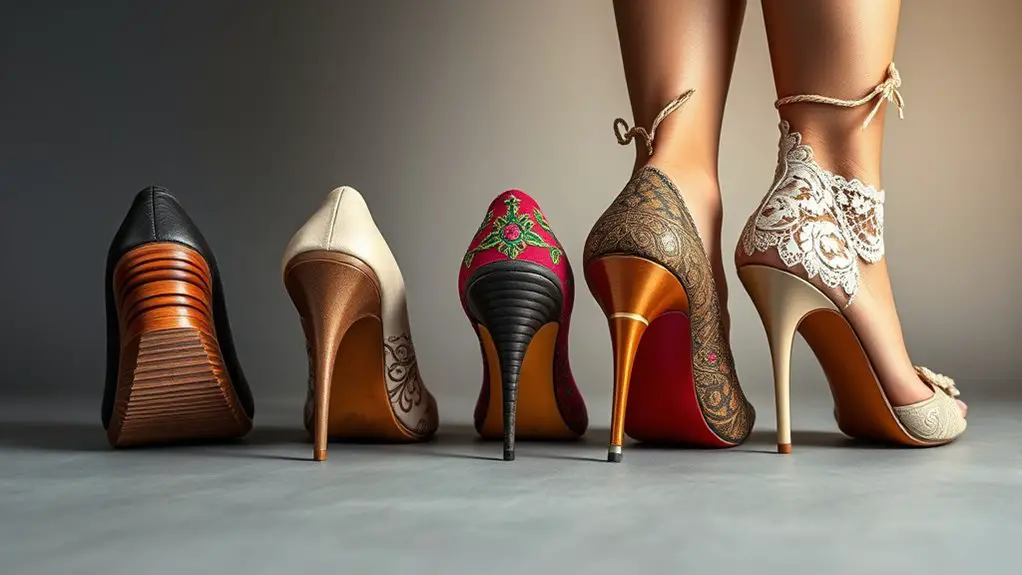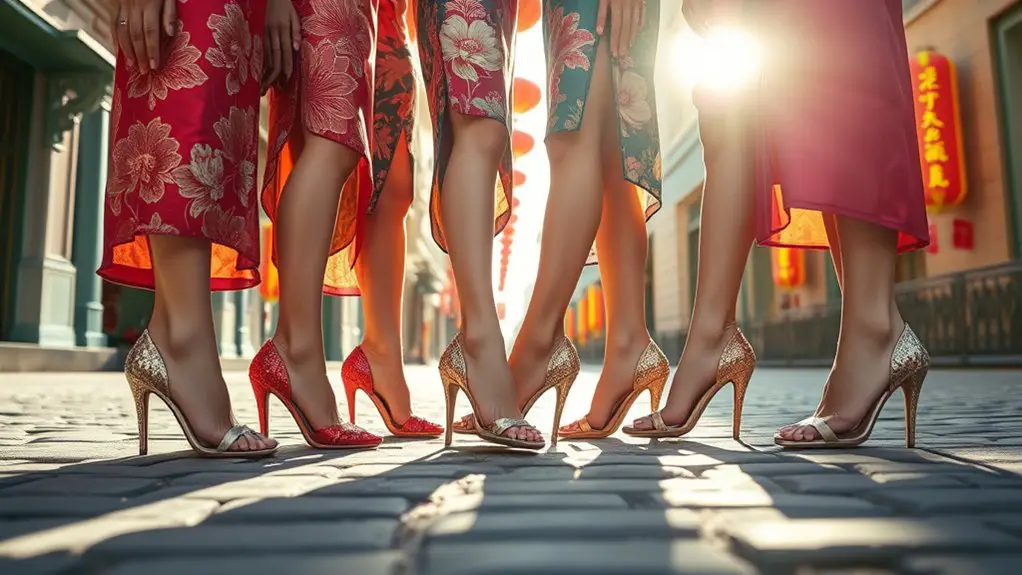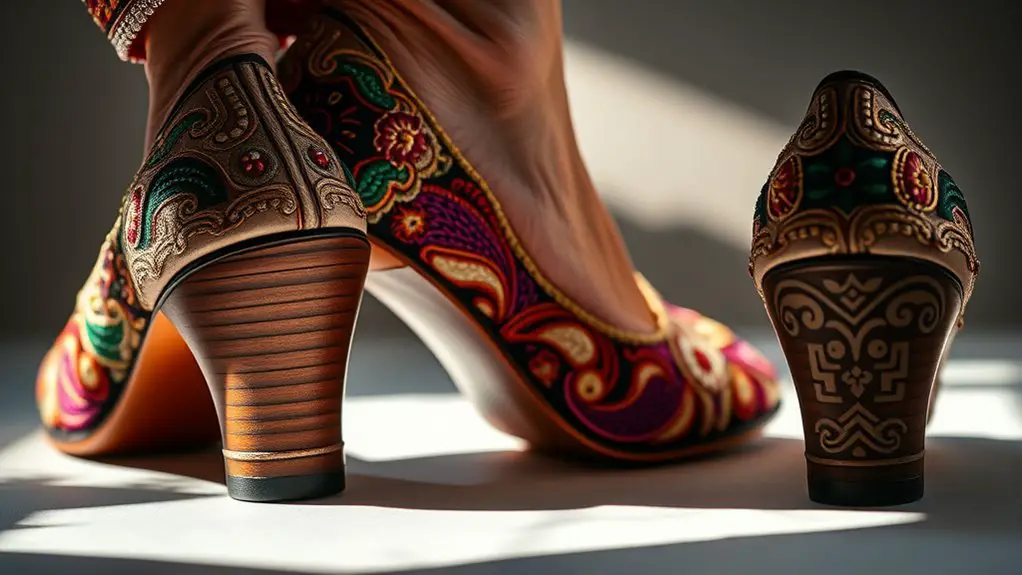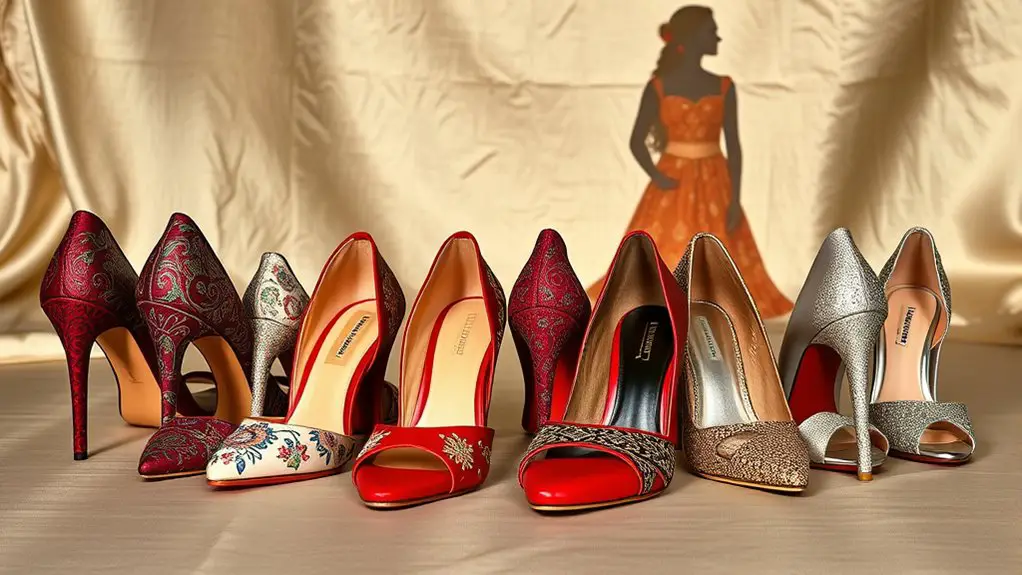Heels play a critical role in traditional fashion, symbolizing cultural identity and social status across various societies. In Europe, they reflect sophistication, distinguishing the elite from the working class. In Asia, traditional footwear showcases artistry, blending functionality with cultural significance. Heels also emphasize femininity and historical gender roles. Additionally, the craftsmanship involved in creating traditional heels illustrates a rich heritage. Discover how these elements have evolved and influenced modern fashion trends across different cultures.
The Historical Origins of Heels

Although many associate high heels with modern fashion, their origins trace back to the 10th century, when Persian cavalrymen wore them to secure their feet in stirrups. This practical design marks the beginning of heel evolution, showcasing how ancient footwear was not merely about aesthetics but functionality. As these heels began to infiltrate European fashion, they evolved from utilitarian items into status symbols, particularly among the elite.
The shift from practical use to decorative flair reveals a significant change in societal values. By the 16th century, heels became a staple in aristocratic attire, reflecting power and sophistication. This historical context illustrates how footwear has always served as a cultural marker, with heels embodying both utility and opulence. Understanding these origins helps you appreciate the complex interplay between practicality and fashion, demonstrating that what you wear often carries deeper historical significance than meets the eye.
Heels in European Traditional Attire
Heels have long played a pivotal role in European traditional attire, serving not just as footwear but as an emblem of social status and cultural identity. In various regions, traditional styles showcase distinctive heel variations that reflect not only aesthetic preferences but also societal norms. For instance, the elaborate platforms of 17th-century France symbolized nobility, while the lower, sturdier heels of rural attire highlighted practicality for laborers.
In Italy, the intricately designed Venetian heels provided an artistic flair, whereas in England, the classic leather brogues with slight heel elevation represented a more understated elegance. Each of these choices in heel design not only conveyed the wearer’s social standing but also indicated cultural values, from the opulence of royal courts to the simplicity of peasant life. Consequently, heels serve as a fascinating lens through which you can explore the rich tapestry of European tradition and identity.
The Influence of Heels in Asian Cultures

While European traditional attire showcases varied heel styles that reflect social hierarchies, Asian cultures present their own distinctive relationship with heel design, merging functionality with artistry. In many Asian communities, traditional footwear often features heels that serve both practical and symbolic roles.
Asian traditional footwear uniquely intertwines functionality and artistry, showcasing heels that hold both practical and symbolic significance.
- Chinese Lotus Shoes: These small, intricately designed shoes highlight the historical practice of foot binding, symbolizing beauty and status.
- Japanese Geta: Elevating the wearer, these wooden sandals balance aesthetics with the need for stability in traditional dress.
- Indian Paduka: Often made from wood, these backless sandals symbolize a connection to spirituality and cultural heritage.
- Korean Hye: Featuring a unique design, these shoes reflect the wearer’s social status while providing comfort.
In each case, the cultural significance of heels in Asian traditional footwear illustrates a blend of artistry and function, deeply rooted in the historical contexts of these societies.
Heels as Symbols of Status and Femininity
Heels have long been associated with status and femininity, often serving as a visual marker of social standing throughout history. When you consider their evolution, these shoes not only elevate physical stature but also symbolize empowerment and confidence for many women. Understanding this connection reveals how heels transcend mere fashion, embodying deeper cultural narratives of gender and prestige.
Historical Status Significance
Throughout history, the evolution of heels reflects not just changing fashion trends, but also shifting societal norms regarding status and femininity. Heels have served as symbols of social hierarchy and gender roles, influencing perceptions of power and elegance.
- Nobility: In the 17th century, heels distinguished the aristocracy from the lower classes.
- Gender Distinction: High heels became a way to emphasize femininity, reinforcing traditional gender roles.
- Fashion Statements: They’ve often been used to convey wealth and sophistication, impacting social interactions.
- Cultural Variations: Different cultures adapted heel styles to signify unique status markers within their societies.
As you explore these aspects, consider how heels have shaped and reflected the complexities of identity and power dynamics throughout history.
Femininity and Empowerment Connection
Empowerment often intertwines with the symbols we choose to embody, and high heels have long served as a potent emblem of femininity. They’re not just footwear; they’re a means of feminine expression that distills the complexities of power dynamics in society. When you wear heels, you’re often stepping into a role shaped by cultural expectations, where height can elevate not just stature, but also perceived authority. This paradox reflects how heels can empower women, challenging traditional norms while simultaneously reinforcing certain status symbols. The allure of heels lies in their ability to convey confidence and sophistication, making them a powerful tool in maneuvering both personal identity and societal perceptions. Ultimately, they encapsulate the intricate balance between femininity and empowerment.
Craftsmanship and Artistry in Traditional Heels

While many may overlook the intricate details of traditional heels, the craftsmanship and artistry embedded in their creation reveal a rich narrative of culture and skill. These heels are not merely footwear; they embody centuries of craftsmanship techniques and artistic expressions, reflecting the unique heritage of their origins. When you examine traditional heels, you’ll notice:
- Materials: Locally sourced materials, like leather and wood, often showcase the environment and resources available.
- Design Patterns: Each design tells a story, often featuring symbols or motifs significant to a particular culture.
- Construction Methods: Techniques passed down through generations highlight the artisans’ dedication and mastery.
- Finishing Touches: Hand-painted or embroidered details elevate the aesthetic, making each piece a work of art.
The Modern Revival of Traditional Heels in Fashion
You might notice that contemporary fashion is increasingly embracing traditional heel designs, blending cultural influences with modern aesthetics. This revival not only pays homage to craftsmanship but also highlights how societal shifts shape our footwear choices today. As fashion trends evolve, the reimagining of these classic styles reflects a deeper connection to heritage and identity.
Cultural Influences on Heels
As traditional heels make a resurgence in contemporary fashion, their cultural influences reveal a complex tapestry of history and identity. These styles often reflect deep-rooted cultural symbolism, showcasing global variations that enrich your understanding of fashion.
- Western Elegance: High heels symbolize power and sophistication in Western cultures, often linked to femininity.
- Eastern Heritage: In some Asian cultures, traditional footwear like the Chinese “lotus shoe” reflects beauty and status.
- African Roots: Heels in African attire can signify wealth and social standing, often adorned with intricate designs.
- Middle Eastern Influence: Traditional heels may highlight craftsmanship and artistry, melding function with cultural expression.
Contemporary Fashion Trends
With the resurgence of traditional heels in contemporary fashion, designers are reinterpreting classic styles to resonate with modern sensibilities. You’ll notice how these heels are often crafted from sustainable materials, reflecting a growing awareness of environmental impact. By merging traditional craftsmanship with eco-friendly fabrics, designers not only honor heritage but also cater to a conscious consumer base.
Incorporating these heels into street style, fashion enthusiasts are pairing them with casual outfits, transforming them into versatile statement pieces. This blend of old and new creates an exciting dialogue within the fashion industry, allowing you to express individuality while embracing cultural roots. As you explore this trend, you’ll find that traditional heels are no longer just formal wear; they’re becoming essential in everyday fashion.
Frequently Asked Questions
How Do Heels Affect Posture and Walking Style?
When you slip on heels, they elevate not just your stature but also your posture. Higher heel heights alter your walking dynamics, shifting weight forward and creating a graceful, yet sometimes precarious, balance that redefines movement.
What Materials Are Commonly Used in Traditional Heel Construction?
In traditional heel construction, you’ll often find wood craftsmanship for stability, paired with various leather types for aesthetics and durability. These materials reflect both functionality and cultural significance, enhancing the overall design and wearability of the footwear.
Are There Health Risks Associated With Wearing Heels?
You’d think wearing heels is just about style, but heel discomfort can lead to serious health risks. Prioritizing injury prevention is wise; balancing beauty and comfort is essential for your long-term well-being.
How Have Heels Influenced Modern Fashion Trends?
Heels have markedly shaped modern fashion trends, reflecting fashion evolution and cultural significance. You’ll notice how they symbolize empowerment and sophistication, influencing designers and consumers alike, while also sparking debates on comfort and practicality in today’s style landscape.
Can Men Wear Traditional Heels in Any Cultures?
Yes, men can wear traditional heels in various cultures, often challenging gender norms. In some societies, heels carry cultural significance, symbolizing status or power, allowing men to express individuality while maneuvering evolving fashion landscapes.



